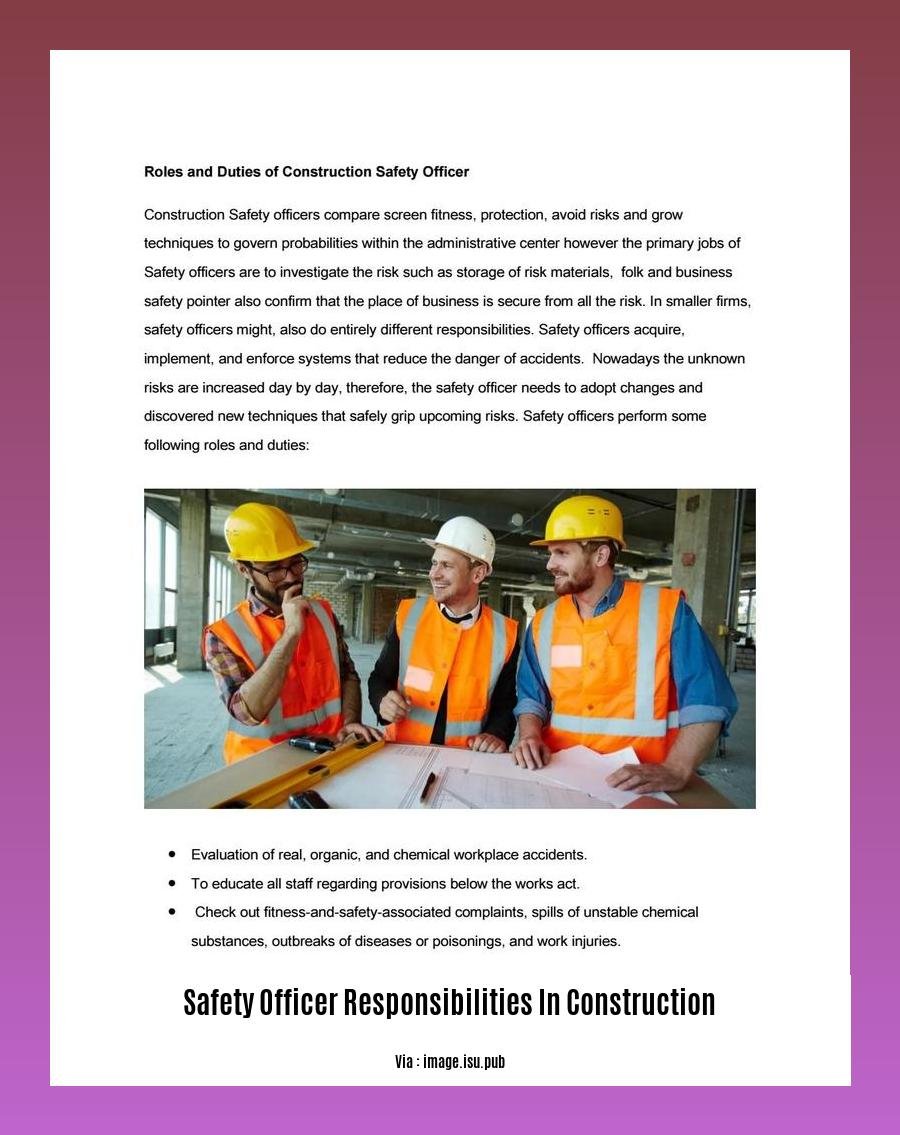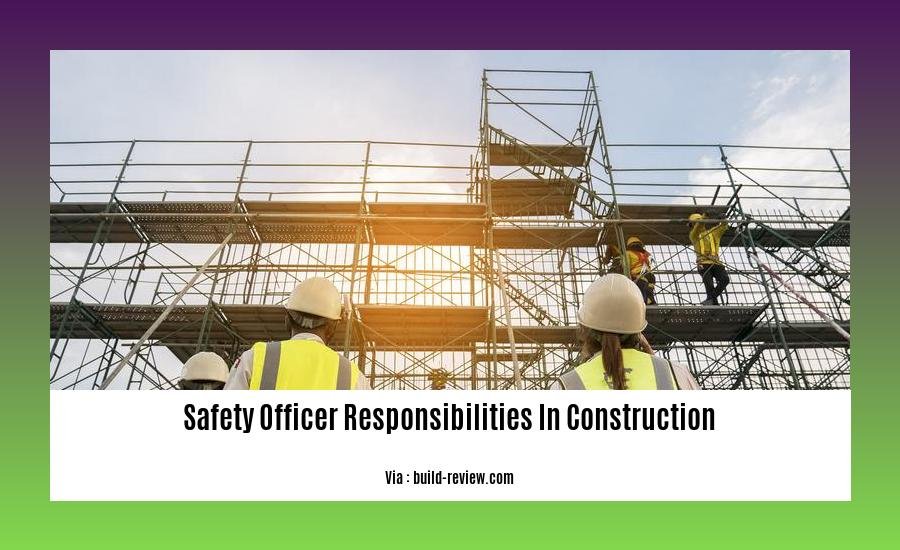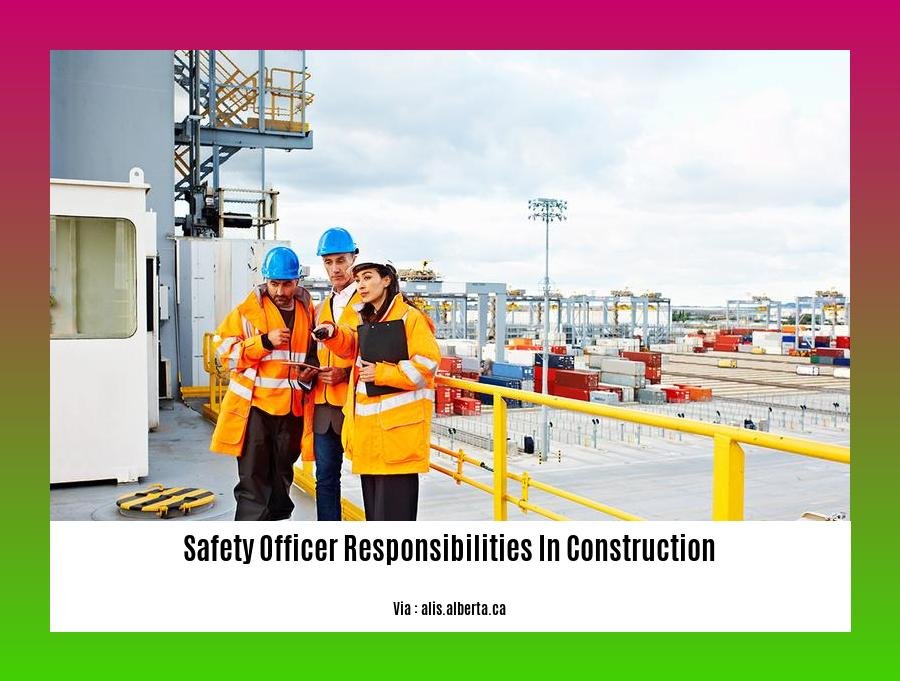Welcome to “Safety Officer Responsibilities in Construction: A Comprehensive Guide.” Safety is paramount in construction, and the safety officer plays a vital role in ensuring a safe and productive work environment. In this guide, we’ll delve into the responsibilities, best practices, and importance of safety officers in the construction industry.
Key Takeaways:
- Assist in developing construction health and safety plans
- Attend project planning meetings and collaborate with managers
- Conduct daily environmental and safety audits
- Inspect workplace complaints and incidents involving accidents, illnesses, or hazardous substances
- Search for and identify physical, biological, and chemical hazards
- Develop, implement, and enforce policies to reduce accident risks
- Verify submission of safety reports to government agencies
Safety Officer Responsibilities in Construction

As a safety officer in construction, you play a critical role in ensuring a safe and productive work environment. Your responsibilities encompass a wide range of tasks, from developing safety plans to conducting inspections and investigating accidents.
Key Responsibilities
- Develop and implement safety programs: Create comprehensive safety plans that outline protocols, procedures, and training programs to minimize risks and promote a culture of safety.
- Conduct safety inspections: Regularly inspect work areas to identify potential hazards, assess compliance with regulations, and ensure ongoing safety measures.
- Investigate accidents and incidents: Thoroughly investigate any accidents or incidents to determine root causes and recommend corrective actions to prevent future occurrences.
- Provide safety training: Train workers on best practices, hazard awareness, and emergency procedures to enhance their knowledge and skills.
- Enforce safety regulations: Monitor compliance with safety regulations and industry standards, ensuring that all workers adhere to established guidelines.
- Communicate safety information: Communicate safety policies, procedures, and updates to workers, subcontractors, and management to foster a shared understanding of safety requirements.
- Collaborate with management: Work closely with project managers and management to integrate safety into project plans and decision-making processes.
- Stay up-to-date on safety regulations: Continuously monitor changes in safety regulations, industry best practices, and technological advancements to maintain a proactive approach to risk management.
Additional Responsibilities
In addition to the core responsibilities, a safety officer may also be involved in:
- Auditing safety programs: Conducting internal audits to evaluate the effectiveness of safety programs and identify areas for improvement.
- Managing safety documentation: Maintaining records of safety inspections, training programs, incident reports, and other relevant documentation.
- Participating in safety committees: Actively participating in safety committees to provide expertise, share ideas, and collaborate on safety initiatives.
- Representing the organization: Representing the organization in safety-related meetings, conferences, and inspections to promote a positive safety culture both internally and externally.
Are you yearning to delve deeper into the fascinating world of safety in construction? Embark on an educational journey with our comprehensive guide to the safety officer’s vital role. Discover the intricacies of the profession, explore industry-specific interview strategies, and gain insights into the safety measures that safeguard construction sites. Click on the links below to unveil the treasure trove of information:
- Safety Officer in Construction Company
- Safety Officer Interview Questions and Answers in Construction
- Safety Officer Roles and Responsibilities in Construction
- Safety Park in Construction Site
Provide Safety Training

Providing effective safety training is a cornerstone of a comprehensive safety program in construction. It empowers workers with the knowledge, skills, and attitudes necessary to work safely and protect themselves and others. Here’s how to approach safety training:
-
Identify training needs: Conduct a thorough assessment of your operations to identify training gaps and specific areas where workers need to enhance their safety knowledge.
-
Develop training materials: Create tailored training modules that cover essential safety topics, such as hazard identification, risk assessment, personal protective equipment, and emergency procedures.
-
Consider various training methods: Utilize a mix of classroom instruction, hands-on exercises, videos, and online resources to cater to different learning styles.
-
Engage workers actively: Encourage active participation by involving workers in discussions, simulations, and exercises. This fosters understanding and improves retention.
-
Ensure regular training and updates: Schedule regular refresher training sessions and provide updates on new safety regulations, equipment, or processes.
Key Takeaways:
- Safety training empowers workers to work safely and prevent accidents.
- Identify training needs through thorough assessments.
- Develop tailored training materials to cover essential safety topics.
- Consider various training methods to cater to different learning styles.
- Engage workers actively to improve understanding and retention.
- Schedule regular refresher training and provide updates on new regulations and best practices.
Sources:
- Roles and Responsibilities of Safety Officer in Construction
- Construction Safety Officer | Duties & Responsibilities
Identify and Mitigate Risks
As a safety officer, your top priority is to keep your team safe. That means being able to identify and mitigate risks on the job site.
Identifying risks involves looking for anything that could cause an accident or injury. It could be a physical hazard, like a slippery floor or a loose ladder. It could also be a behavioral hazard, like someone working without proper training.
Once you’ve identified a risk, you need to take steps to mitigate it. That could mean eliminating the hazard altogether, or it could mean putting in place controls to reduce the risk of an accident.
Here are some tips for identifying and mitigating risks on the job site:
- Conduct regular inspections.
- Talk to workers about potential hazards.
- Review accident reports to identify trends.
- Use a risk assessment tool to help you identify and prioritize risks.
- Develop and implement safety policies and procedures.
- Provide safety training to workers.
- Enforce safety regulations.
By following these tips, you can help to keep your team safe and prevent accidents on the job site.
Key Takeaways:
- Identifying and mitigating risks is a crucial responsibility of a safety officer.
- Risks can be physical or behavioral.
- To identify risks, conduct inspections, talk to workers, and review accident reports.
- To mitigate risks, eliminate hazards or implement controls.
- Safety policies, procedures, training, and enforcement can help prevent accidents.
Citations:
[^
[^
Communicating Safety Regulations and Policies
Communicating safety regulations and policies is a crucial responsibility for construction safety officers. Effective communication ensures that workers understand and follow safety procedures, reducing the risk of accidents and injuries. Here’s how you can communicate safety regulations and policies effectively:
-
Use clear and concise language: Avoid technical jargon and acronyms that workers may not understand. Use simple, easy-to-understand language that conveys the message effectively.
-
Provide regular safety training: Conduct regular safety training sessions to educate workers on safety regulations and policies. Use a variety of training methods, such as presentations, videos, and hands-on demonstrations, to make the training engaging and memorable.
-
Develop and distribute written materials: Create safety manuals, posters, and other written materials that outline safety regulations and policies. Distribute these materials to workers and make them easily accessible on the job site.
-
Use visual aids: Visual aids, such as posters, infographics, and videos, can help workers visualize safety procedures and make them more understandable. Use these aids to reinforce safety messages and make them more memorable.
-
Encourage feedback and open communication: Encourage workers to ask questions, raise concerns, and report any unsafe conditions or practices. Create a culture where open communication is valued and where workers feel comfortable speaking up about safety issues.
-
Lead by example: Safety officers must demonstrate a strong commitment to safety by following the regulations and policies themselves. By setting a good example, you can encourage workers to do the same.
-
Use technology to your advantage: Technology can be a valuable tool for communicating safety regulations and policies. Use email, text messaging, or safety apps to send out safety alerts, updates, and reminders.
-
Involve workers in the safety process: Engage workers in the development and implementation of safety regulations and policies. By involving them in the process, you can ensure that the policies are relevant to their work and that they have a sense of ownership over them.
-
Continuously evaluate and improve: Regularly evaluate the effectiveness of your safety communication efforts. Make changes and improvements as needed to ensure that the regulations and policies are being communicated effectively and that workers are following them.
By following these tips, you can effectively communicate safety regulations and policies to construction workers and create a safer work environment for everyone.
Key Takeaways:
- Use clear and concise language.
- Provide regular safety training.
- Develop and distribute written materials.
- Use visual aids.
- Encourage feedback and open communication.
- Lead by example.
- Use technology to your advantage.
- Involve workers in the safety process.
- Continuously evaluate and improve.
Sources:
- Construction Safety: A Guide for Employers and Contractors
- Effective Safety Communication
‘t ‘m.
- Are Daffodils Perennials?A Complete Guide to Planting & Care - March 31, 2025
- Are Carpenter Bees Dangerous? Stings, Damage, and Control - March 31, 2025
- How to Get Rid of Ants in the Washroom: A Complete Guide - March 31, 2025










